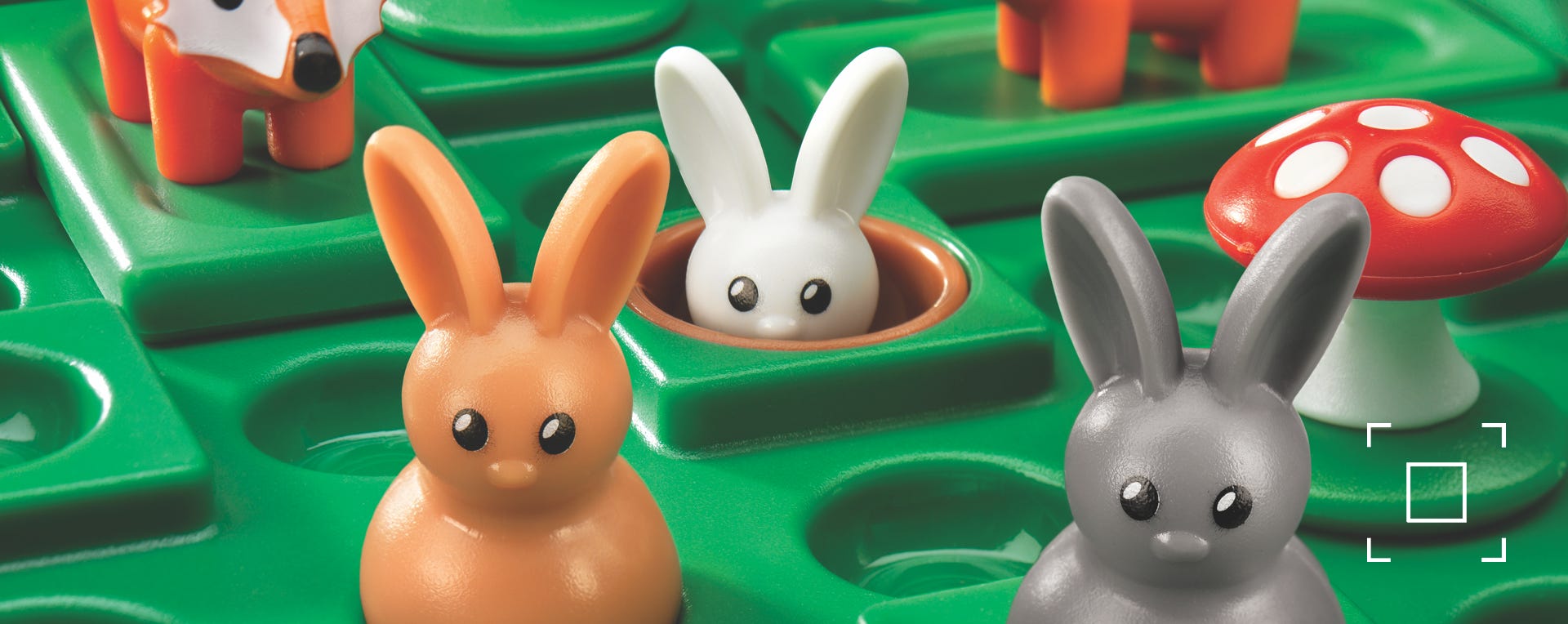
Jump In’
The story behind the creation of Jump In’
Raf Peeters, January 2017
When I designed Dinosaurs in 2015, I originally was working on a concept with rabbits. Although Dinosaurs Mystic Islands is a nice puzzle, I always preferred the rabbit version. But maybe it was not such a bad thing after all that that version never saw the light of day. Because in 2016 I could use the rabbit theme for a completely different kind of puzzle game, one which is a much better fit, because it includes something typical for rabbits: jumping.
THREE LITTLE RABBITS
Of all types of puzzle concepts suitable for a SmartGame, sequential movement puzzles are my favorite ones. The object is not to fill up a grid, but to make different moves in a specific order. Therefor, every challenge turns into a little story: you are going somewhere or you are trying to escape from a place or room. So far I only made a few sequential movement puzzles like this (Camelot JR, Temple Trap and Bill and Betty Bricks).
Many years ago I already tried to make a game with jumping rabbits, a little similar to a peg solitaire. It did work, but it was very limited. Rabbits were tied to specific parts of the grid, similar to how all pawns are tied to either the black or the white squares on a checker board. If you make rabbits jump one another, less than half of the squares can be reached, which limits the number of possibilities and doesn’t offer much variation. Another problem with the old concept was that you could easily make mistakes, because it was not always clear when you reached the end position. And you also needed a lot of rabbits to create some variation. As you know, I prefer to limit the number of puzzle pieces in my game. One of the reasons is that this makes the setup easier and the chance of making errors smaller.
DOWN THE RABBIT HOLE
The first solution to these problems was to allow the rabbits to jump over more that one obstacle. If a rabbit can choose if it jumps over 1 or 2 other rabbits, suddenly all squares on the game board become potential destinations.
The second solution was to make some squares on the game board different: they have a deep brown hole. These rabbit holes are the end positions of the rabbits. Therefor it’s always clear which rabbits are in a right end position and which are not. The nice thing about rabbits is that their ears stick out when they are sitting inside a deep hole, so that it’s still easy to pull them out if necessary. For that reason, a dinosaur game would not be an option this time. First of all because dinosaurs don’t jump over each other, and secondly because they don’t have long ears ;-)
I also added “obstacles” that can’t be moved when you are looking for the solution. Trees were a little too high to jump over and flowers a little bit too low, so we ended up with using mushrooms (a suggestion from my colleague Peter). This also looked great, because the red and white of the mushrooms complement nicely the green color of the game board. The mush rooms alter the game board in three different ways:
• you can’t place any other figure there
• rabbits can use these mushrooms to jump over
• they sometimes cover some of the brown holes, limiting the number of possible end positions for the rabbits.
But the most important game pieces I added were the foxes. You can only slide this piece forward and backward. Without this piece, the game play would result in challenges with many rabbits and/or many similar movement patterns. But the combination of only 1 or 2 foxes with a few rabbits, already resulted in very interesting challenges. When you combine 2 foxes (one horizontal and one vertical on the game board) you can easily create different obstacles of 1, 2 and 3 squares for your rabbits to jump over.
Some of the squares on the game board are slightly higher. Their only function is to help the movement of the puzzle pieces with the foxes. And without those raised squares it also looked like the foxes stood on some kind of surfboard. Now the tiles where the foxes are standing on, blend better with the rest of the game board.
Challenges start really easy so that you get to know the game mechanics. In this game you really need to start with the easy challenges so that you learn to combine the movements of foxes and rabbits to your advantage. If you skip the easy levels and haven’t learned the tricks you need, you will probably think that the only way to solve this game is by trial and error.
Most solutions require about 15 - 30 moves, but if you prefer something more challenging, this game also includes a Wizard level. The hardest challenge requires 87 moves! Challenges often have multiple solutions. The shortest solution is shown in the booklet. The minimum number of moves needed to solve each challenge is indicated above each challenge. Although you can keep on playing forever without the need to start all over, sometimes it is better to reset. If you have for example made more than 50 moves and you see that the challenge can be solved in 10 moves, it’s very likely that your current position is further away from the solution than the actual starting position ;-)
THE QUICK BROWN RABBIT JUMPS OVER THE LAZY FOX
This game is suitable for children of age 6-7 and up. On of the most difficult parts of the development was to make sure that the game and the packaging would not look too childish. Because it’s really fun and interesting for teens and adults too. The people who play tested this game all loved it and so do I. It’s my new favorite SmartGame, at least until 2018.
UPDATE OCTOBER 2017: Jump In’ wins the “Toy of the Year 2017” in Belgium!
UPDATE JANUARY 2018: In 2018 SmartGames will introduce a XXL version of this game, perfectly for schools or demonstrations. This Jump’In XXL version is much bigger and includes 40 extra challenges with a black rabbit on top of the existing 60 challenges (see image below).
UPDATE 2022: There is now also a “Limited Edition” of Jump’In. It’s the same size as the original compact game, but includes the extra black rabbit and 40 extra challenges of the XXL version. The size of the packaging (and price) is that of a classic SmartGame like Walk the Dog (about 20 €).
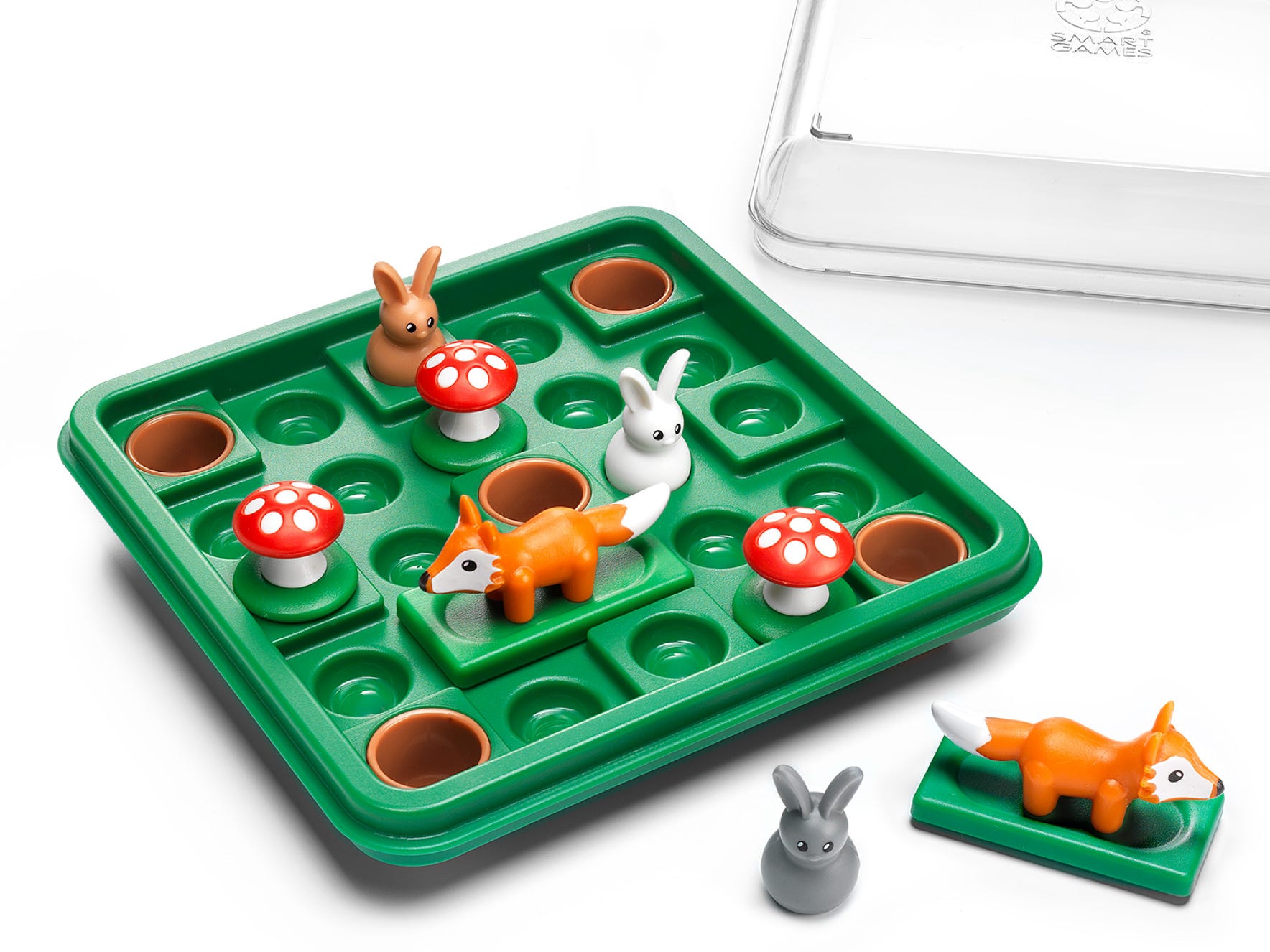
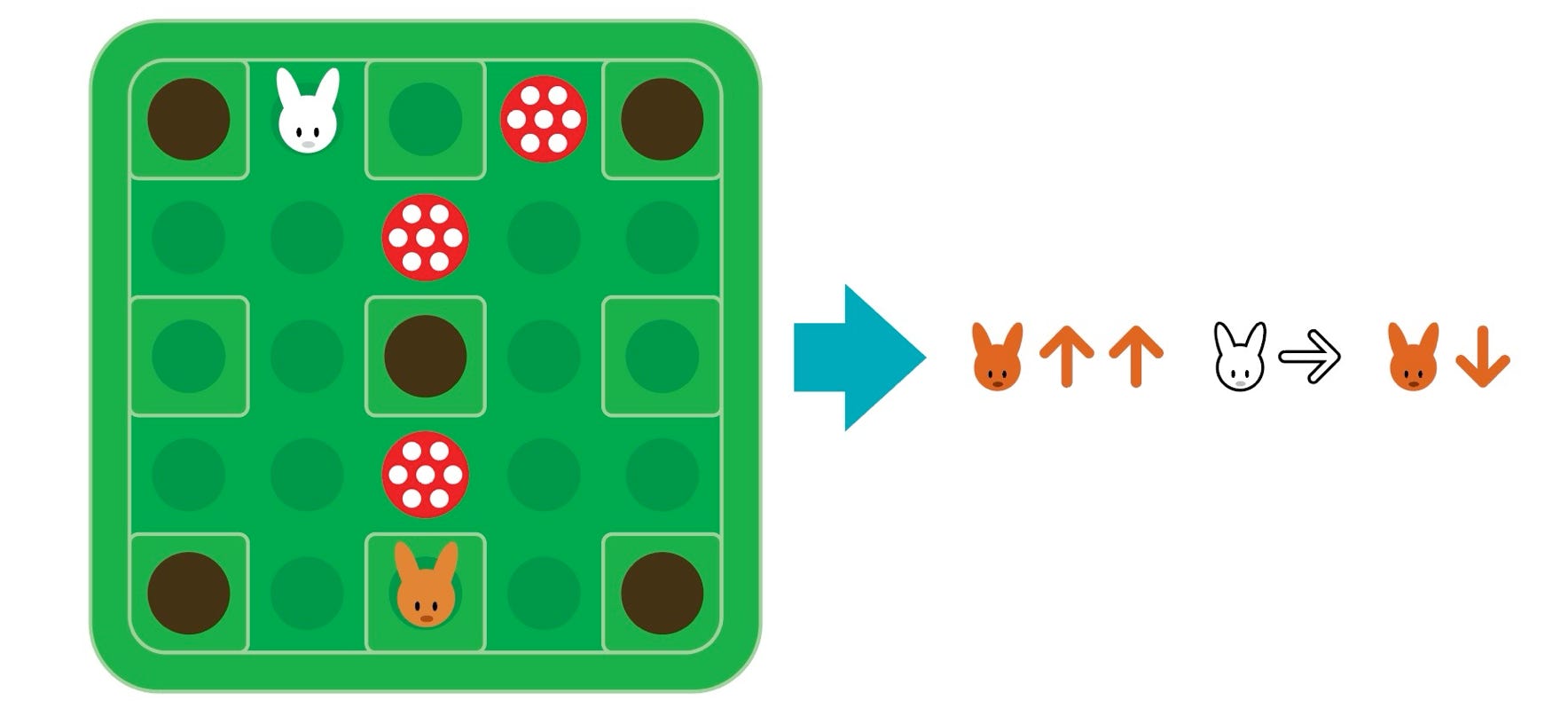
example of a Starter challenge/solution of Jump In’ with 2 rabbits and 3 mushrooms.
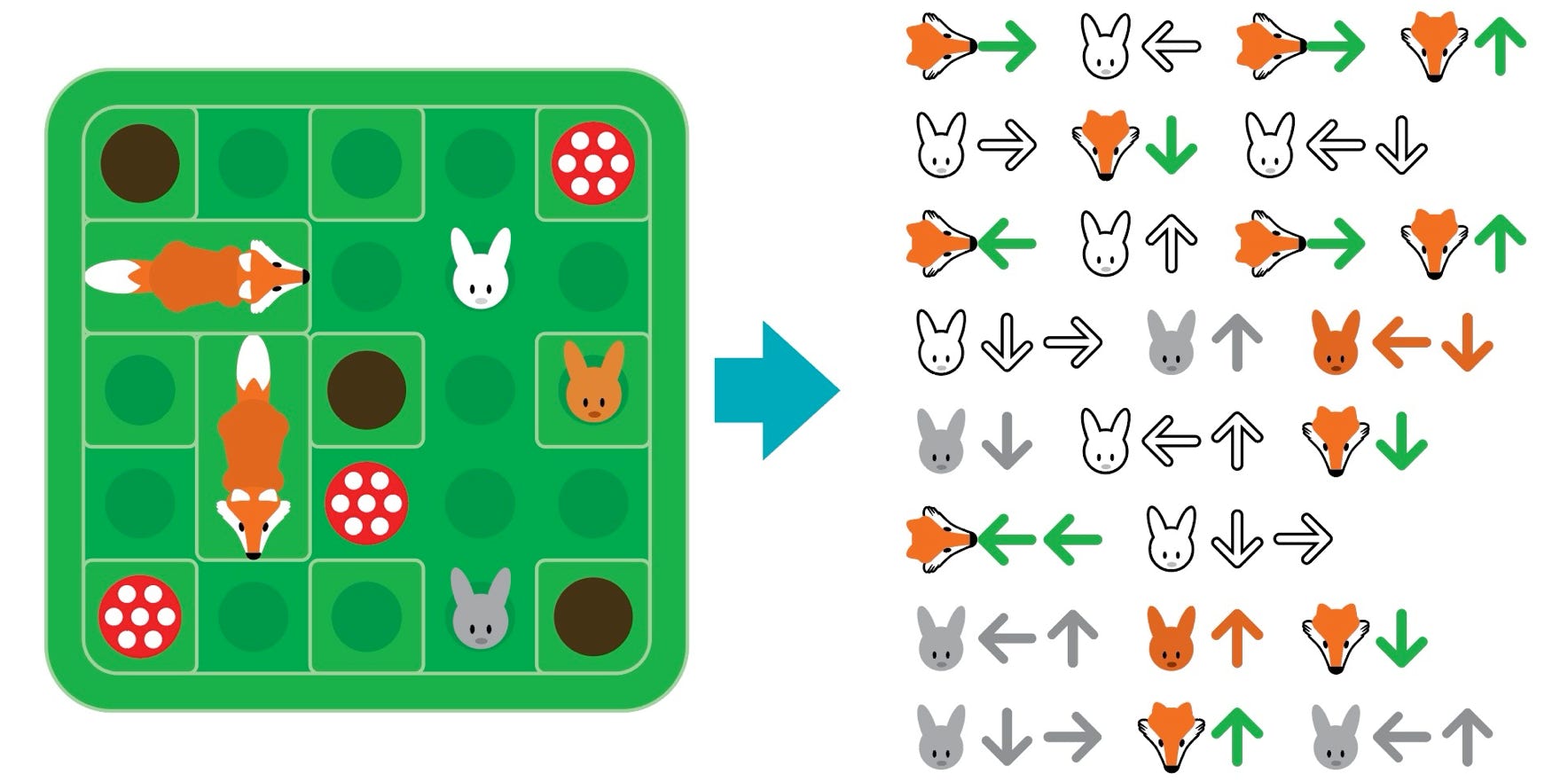
example of a Wizard challenge/solution with 3 rabbits, 2 foxes and 3 mushrooms that can be solved in 34 moves.
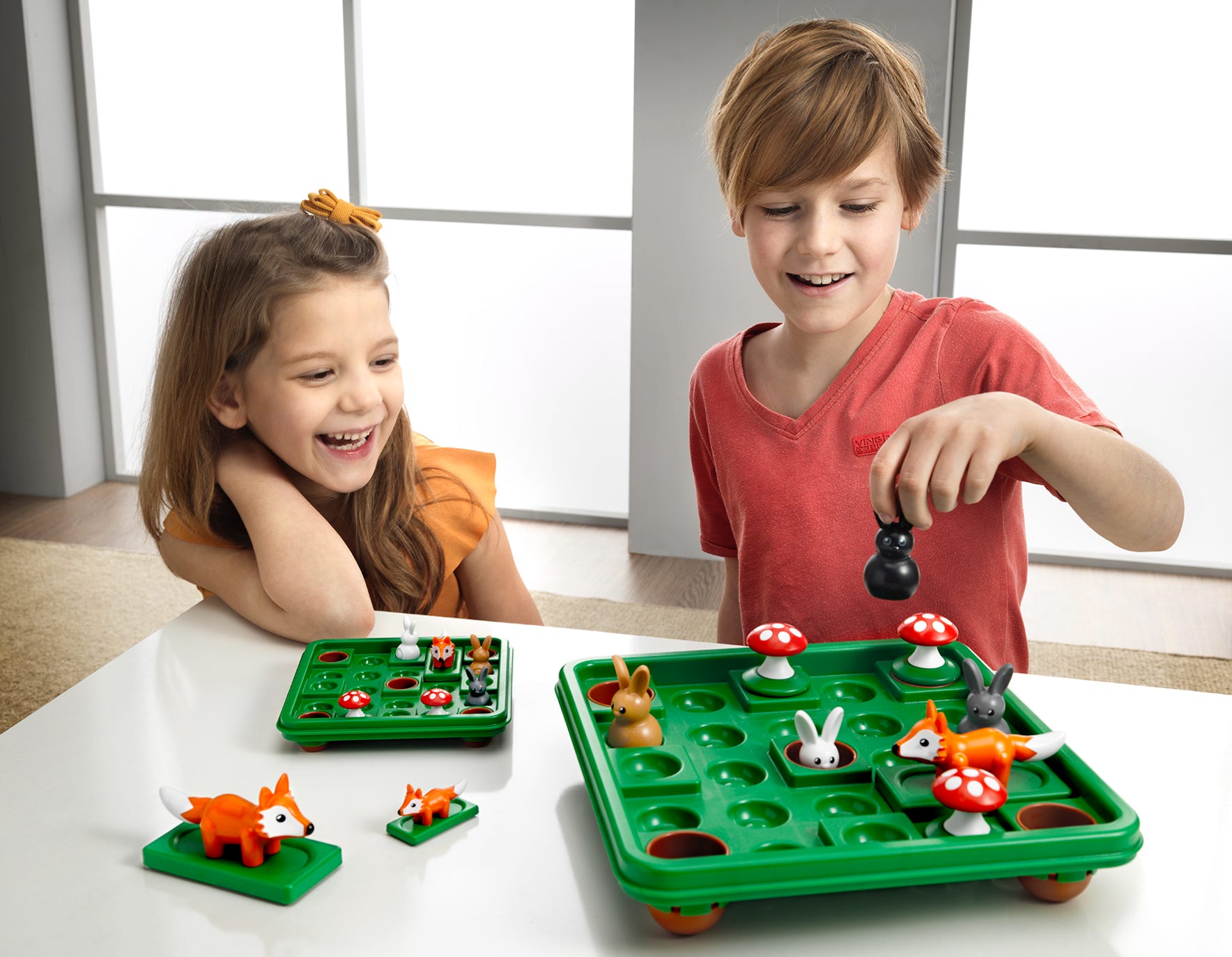
GAME RULES JUMP IN’
1) Select a challenge. Place the rabbits, foxes and mushrooms on the game board as indicated in the challenge.
2) The object of the game is to move the rabbits and foxes around the game board until all of the rabbits are safe in brown holes:
• Foxes move by sliding forward or backward. Foxes cannot jump over obstacles or be placed elsewhere on the board.
• Mushrooms are stationary and cannot be moved.
• Rabbits move by jumping horizontally or vertically over one or more spaces with obstacles: other rabbits, foxes, mushrooms or a combination of these:
• Rabbits must land on the first empty space after a jump - they can never move over empty spaces.
• Rabbits can never move without jumping over at least 1 obstacle, thus they can never move to an adjacent space.
• A hole with a rabbit inside is an obstacle, while empty holes are not obstacles.
• A rabbit can jump into – but not over – an empty hole.
• If needed, rabbits can jump out of holes they are already sitting in.
• Rabbits can jump over a fox no matter the orientation of the fox: tail to front, front to tail, or over the side.
3) You have found a solution when all of the rabbits are inside brown holes! The end position of the foxes is not important.
Website ©2024 Raf Peeters
Products and images: © Smart
